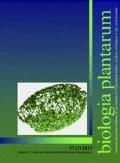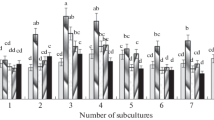Abstract
The changes in cell division rate were studied in different components of the shoot apex ofChenopodium rubrum during short-day photoperiodic induction and after the inductive treatments. Induced and vegetative apices were compared. Accumulation of metaphases by colchicine treatment was used to compare the mean cell cycle duration in different components of the apex. A direct method of evaluating the increase in cell number obtained by anticlinal or periclinal divisions was applied if the corresponding components of induced and non-induced apices had to be compared. The short-day treatment prolonged the cell cycle more in the peripheral zone than in the central zone and still more in the leaf primordia. The importance of changing growth relations for floral transition was shown particularly if the induced plants were compared with the vegetative control with interrupted dark periods. Induced plants transferred to continuous light showed further changes in the rates of cell division. The cell cycle was shortened more in the central zone than in the peripheral zone,i.e. there was a further shift in growth relations within the apical dome. The cell cycle in the leaf and bud primordia was also shortened if compared with the vegetative control, the acceleration being stronger in the bud primordia. There was a subsequent retardation in cell division in the leaf primordia formed during and after the inductive treatment if the plants were fully induced. An inhibition of the oldest bud primordia was observed in fully induced apices, as well.
Similar content being viewed by others
References
Arzee, T., Zilberstein, A., Gressel, J.: Immediate intraplumular distribution of maeromolecular synthesis following floral induction inPharbitis. - Plant Cell Physiol.16: 505 to 511, 1975.
Bernier, G., Kinet, J. M., Bronchart, R.: Cellular events at the meristem during floral induction inSinapis alba L. - Physiol. vég.5: 311–324, 1967.
Bodson, M.: Variation in the rate of cell division in the apical meristem ofSinapis alba during transition to flowering. -Ann. Bot.39: 547–554, 1975.
Cockshull, K. E., Horridge, J. S.: Further evidence of a relationship between size of theChrysanthemum shoot apex and inflorescence development. - Ann. Bot.46: 125–127, 1980.
Corson, G. E., Jr.: Cell division studies of the shoot apex ofDatura stramonium during transition to flowering. - Amer. J. Bot.56: 1127–1134, 1969.
Evans, H. J., Neaby, G. J., Tonkinson, S. M.: The use of colchicine as an indicator of mitotic rate in broad bean root meristems. - J. Genet.55: 487–502, 1957.
Francis, D.: Effects of red and far-red light on cell division in the shoot apex ofSilene coeli-rosa L. - Protoplasma107: 285–299, 1981.
Francis, D., Lyndon, R. F.: Early effects of floral induction on cell division in the shoot apex ofSilene. -Planta139: 273–279, 1978.
Gressel, J., Zilberstein, A., Porath, D., Arzee, T.: Demonstration with fiber illumination thatPharbitis plumules also perceive flowering photoinduction. - In:De Greef, J. A. (ed.): Photoreceptors and Plant Development. Pp. 528–530. Antwerpen Univ. Press, Antwerpen 1980.
Jacqmard, A., Raju, M. V. S., Kinet, J.M., Bernier, G.: The early action of the floral stimulus on mitotic activity and DNA synthesis in the apical meristem ofXanthium strumarium. - Amer. J. Bot.63: 166–174, 1976.
Kohli, R. K., Seidlová, F.: Growth correlations in shoot apices ofBrassica campestris L. during transition to flowering. - Biol. Plant.23: 41–45, 1981.
Krekule, J., Seidlová, F.: RNA synthesis in shoot apices and young leaves ofChenopodium rubrum during three dark periods of photoperiodic floral induction. - Biol. Plant.19: 292 to 299, 1977.
Lance, A.: Recherches cytologiques sur l’évolution de quelques méristèmes apicaux et sur ses variations provoquées par des traitements photopériodiques. - Ann. Sci. Nat. Bot.18: 91 to 422, 1957.
Lyndon, R. F.: Rates of cell division in the shoot apical meristem ofPisum. - Ann. Bot.34: 1–17, 1970.
Lyndon, R. F.: Rates of growth and primordia initiation during flower development inSilène at different temperatures.- Ann. Bot.43: 539–551, 1979.
Miller, M. B., Lyndon, R. F.: Rates of growth and cell division in the shoot apex ofSilène during the transition to flowering. - J. exp. Bot.27: 1142–1153, 1976.
Milyaeva, E. L., Chailakhyan, M. Kh.: Diurnal fluctuation of mitotic activity in stem apices ofRudbeckia bicolor during flower evocation. - Sov. Plant Physiol.28: 302–306, 1981.
Opatrná, J., Ullmann, J., Pavlova, L., Krekule, J.: Changes in organ growth ofChenopodium rubrum due to suboptimal and multiple photoperiodic cycles with and without flowering effect. - Biol. Plant.22: 454–464, 1980.
Philipson, W. R.: Some observations on the apical meristems of leafy and flowering shoots. - J. Linn. Soc. Bot.53: 187–193, 1947.
Popham, R. A., Chan, A. P.: Origin and development of the receptacle ofChrysanthemum morifolium. - Amer. J. Bot.39: 329–339, 1952.
Rolinson, A. E., Vince-Prue, D.: Responses of the rice shoot apex to irradiation with red and far-red light. -Planta132: 215–220, 1976.
Sachs, R. M., Bretz, C. F., Lang, A.: Shoot histogenesis: the early effects of gibberellin upon stem elongation in two rosette plants. - Amer. J. Bot.46: 376–384, 1959.
Seidlová, F.: Growth correlation and RNA synthesis in different parts of the shoot apical meristem ofChenopodium rubrum L. induced to flowering. - Biol. Plant.18: 19–25, 1976.
Seidlová, F.: The rate of cell division in the shoot apical meristem during photoperiodic induction and transition to flowering. - Biol. Plant.22: 428–433, 1980a.
Seidlová, F.: Sequential steps of transition to flowering inChenopodium rubrum L. - Physiol. vég.18: 477–487, 1980b.
Sunderland, N.: Cell division and expansion in the growth of the shoot apex. - J. exp. Bot.12: 446–457, 1961.
Williams, R. F.: The physiology of growth in the wheat plant. III. Growth of the primary shoot and inflorescence. - Aust. J. biol. Sci.19: 949–966, 1966.
Author information
Authors and Affiliations
Rights and permissions
About this article
Cite this article
Seidlová, F., Sádlíková, H. Floral transition as a sequence of growth changes in different components of the shoot apical meristem ofChenopodium rubrum . Biol Plant 25, 50–62 (1983). https://doi.org/10.1007/BF02878267
Received:
Accepted:
Issue Date:
DOI: https://doi.org/10.1007/BF02878267



